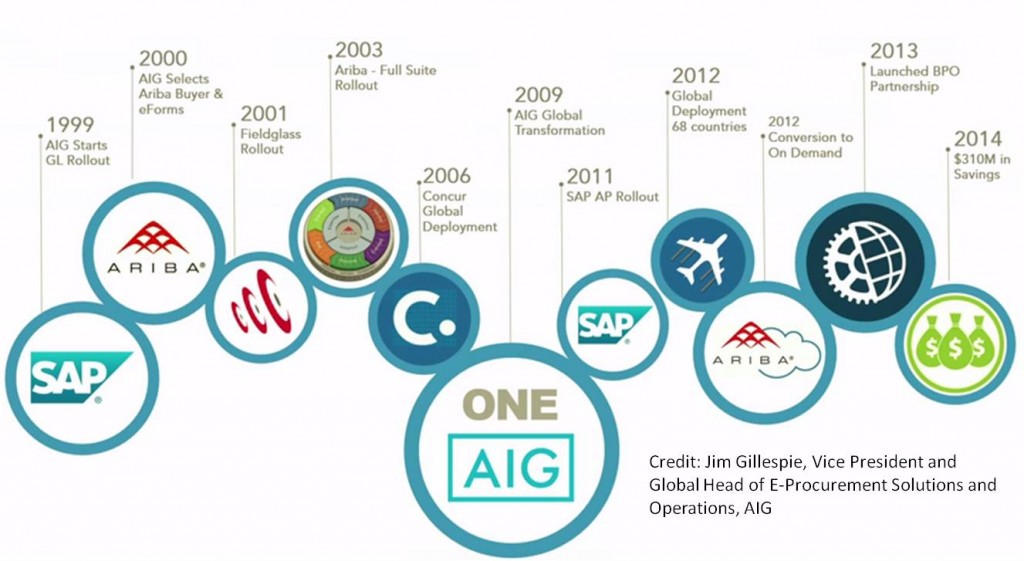Last week our team attended Ariba LIVE, which is arguably, along with the ISM conference in May, one of the two largest and most significant events in our industry. Over the next two weeks, we will provide a flavor of the event via a series of articles focused on company news, keynote presentations, and case studies. We’ll start today with a review and discussion of the Day 1 keynote from AIG’s Jim Gillespie, Vice President and Global Head of E-Procurement Solutions and Operations.
AIG: Poster Child for SAP’s Business Network Family
As most readers know, Ariba was acquired by SAP in 2012. Since then Ariba has worked hard to maintain its identity within its much larger parent, while also partnering with its corporate siblings Fieldglass and Concur. One key to Ariba maintaining its identity (and its relationships with its customers) has been its Ariba LIVE event that is held in both the US and Europe each year.
A central part of each year’s event is the series of mainstage presentations delivered each day as well as the always dynamic and compelling vision set forth by Ariba’s longtime CMO and now SAP/Ariba Executive Tim Minahan. Tim, once again, set the standard as event host extraordinaire, while also engaging a diverse set of Ariba customers who delivered the keynotes each day. While the interviews, transitions,and general flow was seamless, it was a single slide that jumped out at me more than any other aspect. They say that a picture is worth a thousand words, but to SAP (and its constellation of networked stars – Ariba, Concur, and Fieldglass), this picture of AIG’s 16-year technology journey, is worth much, much more than that. Since 1999, AIG has been successful utilizing each of the four distinct entities on their own and combined. This picture was also worth $310 million in savings to AIG last year. I expect we’ll be seeing more on AIG at other SAP-related events in the future.
AIG’s Technology Journey
Arguably the single most important thing to a sourcing organization is knowing what the enterprise is spending, where the enterprise is spending it, and with whom the enterprise is spending it. For Jim Gillespie, AIG’s vice president of global sourcing and procurement services, knowing these three pieces of information is absolutely critical for procurement teams to deliver value to their companies.
Speaking at AribaLIVE 2015 in Las Vegas last week, Gillespie related the story of AIG’s sixteen-year journey that began within the SAP ecosystem in 1999 and extended far beyond it before M&A activity brought it all together under one umbrella and within one network group. Gillespie, who’s only been with AIG since 2010, explained that 2009 marked an inflection point for AIG’s sourcing and procurement strategy. Most, if not all, readers should recall the problems that faced AIG inthat time period. Prior to 2009, AIG had a large number of so-called building blocks for a strong sourcing and procurement strategy. However, Gillespie said, these tools were deployed in a very limited sense prior to 2009.
That year, then-CEO Bob Benmosche focused on centralizing business functions where it made sense. Gillespie said that, as a result of that initiative, Benmosche hired a chief procurement officer in 2010. Gillespie started soon after the new CPO, and he worked with the CPO to quickly make a plan for how to leverage the technology building blocks that AIG had put into place prior to 2009. Prior to this big push, Gillespie noted, “There was a limited amount of spend going through the tools.”
In 2011, Gillespie said, accounts payable became aligned to the procurement organization. According to Gillespie, this can lead to tremendous efficiencies overall [Sidebar: our research has detailed this point in fine detail for many years]. Also as a result of this, invoice receipt was centralized in Olathe, Kan., with a shared services center in Manila, the Philippines, serving as an integral link in the procure-to-pay value chain.
Part of the change to make more use of AIG’s technology also involved trying to globalize spend, which had been problematic with the on-premise version of Ariba they had been using since 2000 (in a limited capacity). The end decision, however, was to move to the on-demand version of Ariba’s platform, which necessitated figuring out how to mimic or eliminate the customizations that had been implemented on the legacy Ariba Buyer solution over the prior decade.
In 2012, Gillespie said, AIG rolled out the on-demand version of Ariba in its United States region and as of today the Ariba on-demand suite is available in the United Kingdom, six countries in EMEA, and—in March—Japan, which is number three on the list of countries with the most spend for AIG. The result of all this work is that AIG currently has $8.3 billion in spend under management, which has netted the company $310 million in cost savings for 2014.
Of the $8.3 billion in spend under management, $5.4 billion currently sits on SAP platforms—including Concur, Ariba, and Fieldglass—with $1.35 billion in additional spend that Gillespie estimates could transition over to Ariba and generate an additional $37 million in savings.
Gillespie has also had success with sourcing legal, which is something that not many procurement teams can claim. On $2 billion of legal spend, Gillespie said, the sourcing and procurement team booked $200 million worth of savings. All told, Gillespie said that the sourcing organization conducted 150 reverse auctions for the AIG Legal Operations Center, which has resulted in legal becoming one of the sourcing team’s biggest internal advocates.
“It’s not all about the technology,” Gillespie said, “It’s about the partnerships you form with the organizations in your firms.”
To that end, AIG’s goals in the next few years are a mix of technology and process objectives. Mobility figures strongly into AIG’s plans for 2015, as the company already has the Concur mobile app for travel and expense management and intends to get mobile procure-to-pay on board in the near future. Gillespie also said AIG plans to do a pilot with the SAP Fiori platform to drive invoice approvals in the United States.
For that matter, AIG intends to continue with its global rollout of new processes and technologies. This includes wrapping up the Concur and Ariba P2P implementations in Japan and continuing the rollout through other geographies as well. Compliance figures strongly into AIG’s future plans, and in fact, the insurer plans to book significant savings through contract compliance, according to Gillespie.
Data is also a strong competitive differentiator now and in the future. Gillespie said that his sourcing team has become so adept at pushing spend visibility, and shown the discipline’s value so strongly, that now the executive briefing report includes spend visibility data at all times, which allow current CEO Peter Hancock and the rest of his team to review spend data before meeting with clients and prospective clients. Enhancing this data has been and will always be a huge goal for AIG going forward, Gillespie said.
“As sourcing professionals … we have the ability to make an impact on our businesses and we need to go do that,” Gillespie said, “We need to create those lasting partnerships [with other teams] … and we need to harness the power of the technology that we’ve all deployed and are embarking to deploy at our companies.”
RELATED ARTICLES
Ariba LIVE 2014: “The Outcome Economy”
Ariba LIVE 2014: Deutsche Bank’s “No Budget, No PO, No Pay” Plan
Ariba LIVE 2013: Keynote from Down Under
Scott Singer – Global Procurement Transformation in the Cloud at Rio Tinto (Ariba Live)
Collaborative Sourcing and Other Thoughts




Pingback: Payables Place AribaLIVE 2015: Looking to the Future of Business Commerce - Payables Place